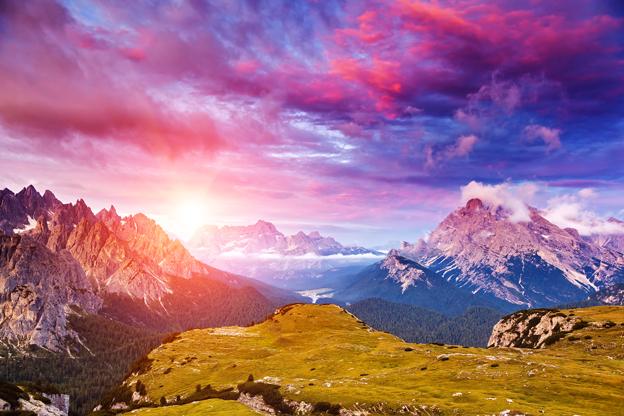“The most beautiful work of architecture ever seen”. This is how Le Corbusier, one of the most prominent architects of the 20th century, has described the Dolomites, one of Italy’s 50 UNESCO World Heritage sites.
A magnificent architectural work indeed, and it’s all natural: glaciers, towering spires, pinnacles, mountains shaped by the elements, where the Italian, German and Ladin cultures intersect. The Dolomites offer breathtaking views and a fantastic background, both in summer and winter, for those who love sports and the outdoors.
Making up the mountain chain of the eastern Alps, the Dolomites cover an area of 141.903 hectares encompassing three regions, Trentino Alto Adige, Veneto and Friuli Venezia Giulia, and five provinces - Trento, Bolzano, Belluno, Pordenone e Udine. They include 18 peaks rising above 3,000 meters.
The mountain groups include the Brenta Dolomites, the Catinaccio and the Latemar, between Alto Adige and Trentino; the Dolomites of Sesto and the Pale di San Martino; the massif of Marmolada, Pelmo and Croda da Lago, and the Friulian Dolomite chain, at the easternmost point.
The chain’s westernmost point is the Brenta Group, where you can find the “Queen of the Dolomites”: Madonna di Campiglio, one of Italy’s most important ski resorts. The area features more than 60 km of slopes and 20 ski lift facilities. Here, the “3-Tre” slope is a favorite; the name refers to the "Three Races of Trentino", special slalom contests taking place during the World Cup of Alpine Skiing. Another favorite is the steep Spinale Direttissima.
Another popular area for winter sports lies east of Trento, between the Val Cismon and the Val di Fiemme and Val di Fassa, with famous mountain resorts like San Martino di Castrozza, Predazzo, Cavalese, Moena (where I learned to ski as a five-year-old!) and Canazei, surrounded by the gorgeous summits of Mounts Sella, Sassolungo and Marmolada.
In the northernmost section, in the Province of Bolzano, is Val Gardena with Ortisei, Santa Cristina and Selva. Here you will find one of the most spectacular and famous downhill ski slopes in the world, where the World Cup in Freestyle Skiing is held every year: the Saslong.
The Saslong is part of the Dolomiti Superski, one of the largest ski areas in the world, passing through Val di Fassa, Val Gardena and Val Badia: 1,220 km of slopes, where you can use the same skipass.
One of the areas that make up the Dolomiti Superski is the fantastic Plan de Corones, definitely one of the top ski resorts in Europe, where I had the pleasure to spend many “settimane bianche” during my childhood. At the foot of Plan de Corones is the Isarco Valley, highly recommended during the Fall season to admire the foliage. And let’s not forget about the Val Pusteria, with the picturesque villages of Brunico and San Candido.
The famous Tre Cime di Lavaredo (Three Peaks of Lavaredo) stand between Alto Adige and Veneto, hovering over the “Pearl of the Dolomites,” Cortina d’Ampezzo. Seat of the 1956 Winter Olympic Games, Cortina is a glitzy resort, attracting national and international VIPs, but is also a top destination for mountain and nature lovers. It is located amid two major valleys, Val di Fassa and Val Gardena, amid the spectacular panorama of the Sella mountain range.
At the base of the National Park of the Bellunesi Dolomites are the imposing Marmolada, Monte Civetta and Pale di San Martino.
The Dolomites take their name from the French geologist Dieudonné Dolomieu, who discovered the properties of the dolomite, a mineral found in large quantities in these mountains, which gives them their particular white color; at sunrise and sunset, the rocks change hues, going from pink to purple to red: locals call this transformation the enrosadira. This process can be explained by the fact that up until 250 million years ago, these mountains were a mass of shells, corals and algae under the sea.
They emerged 70 million years ago, to create “the most beautiful work of architecture ever seen”.





